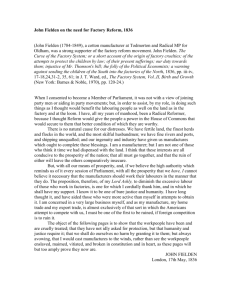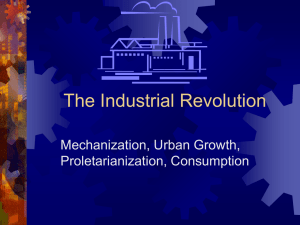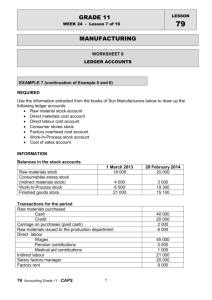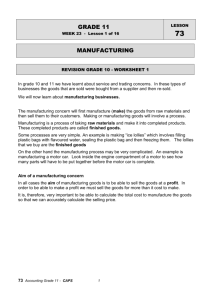MANUFACTURING: LEDGER ACCOUNTS 18 JULY 2013 Key
advertisement
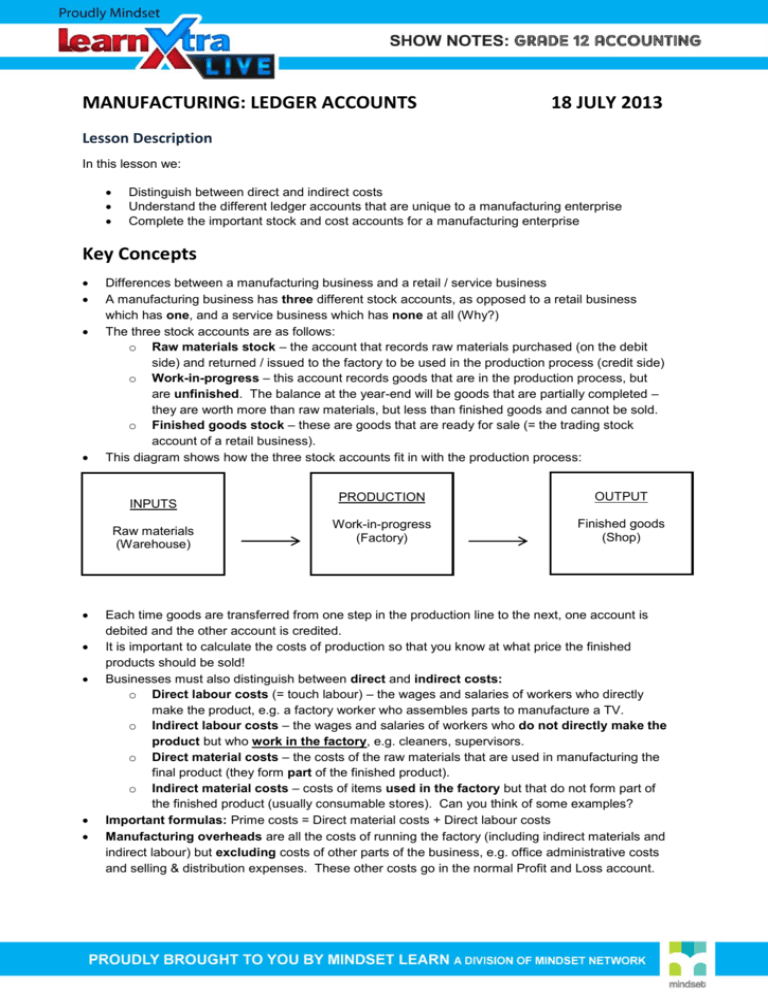
MANUFACTURING: LEDGER ACCOUNTS 18 JULY 2013 Lesson Description In this lesson we: Distinguish between direct and indirect costs Understand the different ledger accounts that are unique to a manufacturing enterprise Complete the important stock and cost accounts for a manufacturing enterprise Key Concepts Differences between a manufacturing business and a retail / service business A manufacturing business has three different stock accounts, as opposed to a retail business which has one, and a service business which has none at all (Why?) The three stock accounts are as follows: o Raw materials stock – the account that records raw materials purchased (on the debit side) and returned / issued to the factory to be used in the production process (credit side) o Work-in-progress – this account records goods that are in the production process, but are unfinished. The balance at the year-end will be goods that are partially completed – they are worth more than raw materials, but less than finished goods and cannot be sold. o Finished goods stock – these are goods that are ready for sale (= the trading stock account of a retail business). This diagram shows how the three stock accounts fit in with the production process: INPUTS Raw materials (Warehouse) PRODUCTION OUTPUT Work-in-progress (Factory) Finished goods (Shop) Each time goods are transferred from one step in the production line to the next, one account is debited and the other account is credited. It is important to calculate the costs of production so that you know at what price the finished products should be sold! Businesses must also distinguish between direct and indirect costs: o Direct labour costs (= touch labour) – the wages and salaries of workers who directly make the product, e.g. a factory worker who assembles parts to manufacture a TV. o Indirect labour costs – the wages and salaries of workers who do not directly make the product but who work in the factory, e.g. cleaners, supervisors. o Direct material costs – the costs of the raw materials that are used in manufacturing the final product (they form part of the finished product). o Indirect material costs – costs of items used in the factory but that do not form part of the finished product (usually consumable stores). Can you think of some examples? Important formulas: Prime costs = Direct material costs + Direct labour costs Manufacturing overheads are all the costs of running the factory (including indirect materials and indirect labour) but excluding costs of other parts of the business, e.g. office administrative costs and selling & distribution expenses. These other costs go in the normal Profit and Loss account. Usually some numbers will be left blank in the ledger accounts and you will be required to calculate them for exam purposes. That’s why it is very important to understand the relationships between the various ledger accounts! Questions Question 1 Marshall Manufacturers produces parts for electrical appliances that they sell to various retailers at a mark-up of 40%. Their financial year ends on 28 February each year. Prepare the ledger accounts in your answer book using the information that follows. Information The following opening balances appeared in the books on 1 March 2012: Raw Materials Stock Work-In-Progress Finished Goods Consumable Stores on Hand R54 000 R14 000 R25 000 R1 000 Transactions for the year 1. 2. 3. 4. 5. 6. 7. 8. 9. Total purchases of raw materials were R480 000 (60% on credit). Raw materials worth R21 000 were returned to creditors. Indirect materials bought for the factory on credit were R17 000. Salaries and wages amounted to R220 000. This must be divided in the ratio 5:3:2 between direct labour, indirect labour and salaries of office staff (with direct labour being 5 parts and indirect labour 3). Medical aid deductions for the employees come to R88 000. The business contributes R2 for every R1 contributed by the employee. Office insurance amounted to R64 000 for the year. Factory insurance is double that of the office insurance. Rent amounting to R620 000 was paid during the year. The factory uses 80% of the available floor space. Total sales were R2 800 000 for the year. Other factory expenses were: Electricity R90 000 Depreciation on factory equipment R22 480 Closing balances on 28 February 2013: Raw materials stock Work in progress Finished goods Consumable stores on hand R12 000 ? ? R3 000 Answer Booklet DR BALANCE SHEET ACCOUNTS SECTIONS RAW MATERIALS STOCK ACCOUNT WORK-IN-PROGRESS STOCK ACCOUNT FINISHED GOODS STOCK ACCOUNT FINAL ACCOUNTS / COST ACCOUNTS SECTION DIRECT LABOUR COST ACCOUNT CR DIRECT MATERIAL COST ACCOUNT FACTORY OVERHEAD COST ACCOUNT


